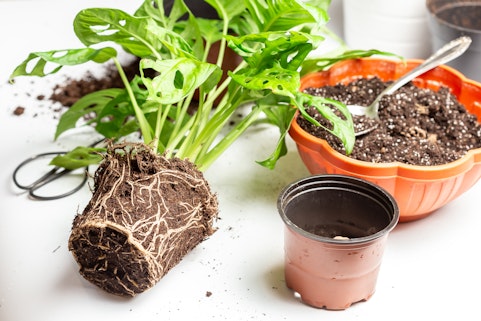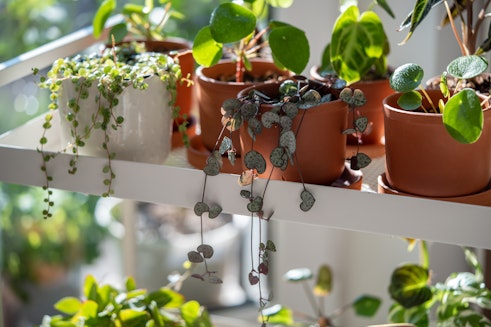
- Home
- Keeping Plants in Winter; What to Expect

Summer is great for plant enthusiasts. Everything grows, everything changes, products are hugely accessible and you have plenty of planty-things to be getting on with. September rolls around and suddenly things seem to slow down, the days get shorter and your plants seem a little lethargic. Then winter arrives. Sigh. You pace around your home, noticing how everything looks exactly the same as it did 2 weeks ago when you last did this. That plant that you had to pay close attention to in the summer, sits there needing no help at all. Winter can be bleak for plant-people. However, there are some things you can do: preparing yourself for the spring, helping your plants gently cruise through this unfavorable season or even tricking them into thinking it's still summer! All this, below.
What is Dormancy?
Dormancy is a survival tactic that most plants have evolved. Plants that exist in places that have harsh winters tend to die back and live dormantly in the soil to survive the harsh conditions. Alternatively, a large number of plants are able to exist and grow consistently in their environment. This is true for most houseplants, which are present in tropical and sub-tropical climates.
For tropical and sub-tropical plants dormancy is quite different. They are equipped to survive reduced light levels by entering a dormant state, where they reduce energy use to the bare minimum to survive until such time as the light levels improve. This serves them in the wild to outstay competitors that have perhaps grown above them, or to survive strange weather conditions or natural disasters like dust or ash clouds. In the UK, they use them to survive our low-light winters.
Do I have to keep my plants differently through the winter?
Yes. Without exception. Plants have a reduced ability to do anything when they are in lower light conditions. This means they take up less water, less nutrients and grow a lot less, if at all. In the short days of winter, plants take in just the energy they need to keep them ticking over until the spring. This means they have to be treated accordingly.
Watering - Reduce watering a significant amount. It is unwise to use a weekly or fortnightly schedule in the winter. Instead, get used to the weight of the plant, and use it as an indication of how much water they are holding on to. Only water if you are certain the plant is dry. In cases such as cacti or other desert plants, some find that they do not need water through the whole season.
Feeding - In general, plants do not need fertilization throughout the winter months. A lot of them lack the ability to take up any significant amount of nutrients, so that fertilizer left behind sits and festers in the soil, encouraging other little nasties to grow in there.
Repotting - While repotting is not guaranteed to harm your plants during the winter months, the risk of shock is greatly increased. Seeing as your plant will not be doing much over the winter anyway, it is probably best to wait until the spring, unless a repot is desperately needed in the case of root rot, overwatering or a pest infestation.
Temperature - any sudden or extreme cold can shock a plant very easily, it is best (if possible) to keep your plants at a steady temperature of around 15-23˚C. Lower temperatures will not kill your plants instantly, but will make them struggle a little over a long period of time. Frost will kill your plants instantly, so try to avoid leaving a window open all night. If you're placing an order online and temperatures are low, opt to include a heat pack and winter packaging to protect your plant on its journey.
Other types of overwintering - Some plants have evolved to snugly tuck themselves away through the winter. For these plants, it is good to allow them to do so, cutting them back to start regrowth again in the spring. For this reason, is important to know your plant before winter comes, so that you can understand what care it needs in the winter.
Can I give winter a miss?
Unfortunately, we humans are not yet advanced enough to control the sun. But we can do the next best thing… We can convince the plant that it is summer all year round and keep them growing! The best way to do this is with a bit of local environment control, which can be achieved using a grow light and some central heating! If you keep the grow light on your plant for 12 hours a day, and keep the room nice and toasty, then plants will continue to grow as if the seasons never change! In cases like this, all the above care advice can be ignored and plants can be watered and fed as normal! Check out our blog about grow lights for more information about them and how to use them.

Do any plants grow through the winter?
There are a number of cool plants that you can keep inside in the winter that will keep your interest piqued even through these bleak months!
Hippeastrum - Hippeastrum is a flowering plant in the Amarylliaceae family. It is often sold as a potted bulb, which blooms to produce a stunning flower in the winter months, before retracting back into the soil.
Narcissus tazetta - N. tazetta is the daffodil’s christmassy cousin, flowering through the winter months and producing white, daffodil-like blooms, it is a great plant for keeping over the winter.
Hyacinth - Winter hyacinths (Hyacinthus orientalis) is a flowering plant in the asparagus family, that produces torch-like, compound inflorescences in the winter, available in many colours!
Euphorbia pulcherrima - E. pulcherrima or Poinsettias are a commonly kept, Christmas houseplant. These plants have tiny flowers in the centre of their leaves called cyathia, and pollinators are attracted to these flowers by the bright red leaves that are present around them. These plants are turned red in a photoperiodic process in which the chemicals to do so are released in periods of darkness. This means that the longer the plant is exposed to darkness, the redder it goes. In the winter, due to the long nights and short days, the plant goes very red and resultantly is used as a winter houseplant.
Schlumbergera - Schlumbergera is a genus of plants in the cactus family that are famous for their hanging foliage and ability to bloom during the darker months of the year. The plants are easy to encourage flowering and you can even be selective about when they flower, and they are available in multiple colours. For Autumn/Winter see the ‘Thanksgiving cactus’ (Schlumbergera truncata) or for Spring see the ‘Easter Cactus’ (Schlumbergera russelliana).

Jonathan Davies
Jonny has worked at Root since May 2023. His love for plants was inherited initially from his grandparents and parents, but really took off once he moved into his own place, where he started picking up small plants and was fascinated by watching how they grow and change over time. Jonny has a degree in Archaeology and Classics from the University of Sheffield, and a masters in Egyptology from Swansea University, where he primarily focused on garden culture in the ancient world, which he has managed to extend to a PhD thesis in the University of Liverpool, where he has been able to combine his love for plants with his love for ancient language and culture. Jonny loves being in the natural spaces around North Wales and Cheshire where he used to go growing up, and often spends hours examining the plants and trees, and kicking up the leaf litter searching for mushrooms and insects. He is fascinated most by plant biology, taxonomy and learning about ecosystems and interactions between plants and their environmental counterparts, and enjoys tending to his varied array of houseplants, and ongoing ‘plant projects’, such as growing plants from seeds and creating living epiphyte displays. Aside from his green thumb, his other interests include: art, reading, listening to and playing music in the company of his cats, Spooky and Boo.
More by Jonathan DaviesRelated Articles
View all articles

General Houseplant Care
Propagating Plants - Making new plants from the ones you have already
By Jonathan Davies



